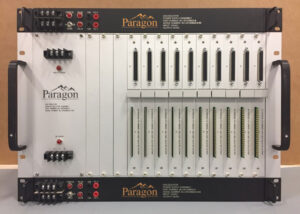Driving needed results for a needed plant computer upgrade

In this case example, a data acquisition and monitoring system manufactured by RTP had been installed in the plant for many years. It handled a variety of analog current loop input signals and dry contact monitoring. The original system was procured as safety-related and had become obsolete.
The objective was to upgrade the system to a model in current production, but the plant also wanted to re-classify it as non-safety-related so that it could be procured commercially. An isolator system was required to be installed between the 1E signals coming in, and the new non-1E plant computer. An additional objective was to minimize the amount of fieldwork and plant labor cost.
Identifying a plan to overcome upcoming challenges
The plant computer system handles a large quantity of signals, and the isolator system was specified to handle a minimum of 100 analog signals and 200 dry contacts, with a total of four identical systems being supplied to the plant. A system using off-the-shelf components would be large, expensive, and would likely have a long lead time due to the quantities required.
The isolator system was required to provide IEEE 384 isolation between the 1E signal inputs and the non-1E signal outputs, while maintaining analog signal integrity from input to output. It must prevent the propagation of any postulated fault on the non-1E side to the 1E circuits.
The isolator system was required to meet seismic qualification (IEEE 323, 344) and EMC requirements (EPRI TR-102323), including emissions and susceptibility. Surges and transients occurring on the non-1E side of the isolator were not allowed to be transmitted to the 1E side, to prevent the 1E signals from being affected.
A tight frame? Paragon can deliver.
In addition to these technical challenges, and due to a previous vendor’s inability to deliver the product, the lead time on the order was extremely expedited: only four months to complete the design and qualification and deliver four complete isolator systems.
The solution provided by Paragon consisted of custom-designed isolators and associated power supplies, built from the ground up to meet the nuclear isolation and qualification requirements.
Paragon designed a compact isolator system that could be built and supplied in the required timeline by producing custom circuit board assemblies and using off-the-shelf rack enclosures. By manufacturing the system in Paragon’s NQA-1 production facility, the team leveraged resources for a quick turn manufacturing run.
The system was designed for IEEE 384 isolation function, which is accomplished by separating the 1E and non-1E interfaces and providing maximum isolation. The isolator system also provides channel-to-channel isolation.
Streamlining the work process

To minimize fieldwork, the isolator’s electrical interfaces were tailored to the existing connectors on the plant computer and the new connectors on the replacement plant computer. The 1E side of the isolators was designed so that the existing terminal blocks and cable assemblies that were connected to the card edge interfaces of the plant computer, were able to remain in place and were simply unplugged from the plant computer and plugged into the isolator after it was installed. The non-1E side of the isolators followed the D-sub connector pinout of the replacement plant computer, which allowed the cabling from the isolators to the new plant computers to be implemented with off-the-shelf D-sub cables.
This meant that the system only required a small quantity of cables to be plugged into the new system, along with a handful of discrete wires for the power supplies—as opposed to the hundreds of wires that would need to be installed and verified if the original cabling and connectors were not reused (typically three wires per analog signal for +, -, and shield; two wires per dry contact—a total of approximately 700 wires per system!).
The compact design of the analog and dry contact isolator systems only occupies a total of 8U of rack space each—6U for the isolator card rack and 2U for the power supplies—that’s only 14” of vertical space for either the analog isolator system with up to 104 analog signals, or the dry contact isolator system with up to 208 contacts.
Lasting and substantial results
The isolator system provided by Paragon saved time and money for the customer. The innovative design solved the challenges faced by the customer and met all specification requirements and is currently in use by the plant. The system is low maintenance, can be tested and adjusted by the plant if needed, and will be supported long-term by Paragon, who is committed to the future of the nuclear industry. The isolator system provides a rugged, proven basis for future I&C designs for nuclear power plants.
This is just one example of why Paragon is the Nuclear Industry’s most trusted supplier.
